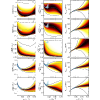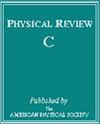Bayesian inference of the dense matter equation of state built upon extended Skyrme interactions
IF 3.4
2区 物理与天体物理
Q1 Physics and Astronomy
引用次数: 0
Abstract
The nonrelativistic model of nuclear matter with Brussels extended Skyrme interactions is employed in order to build, within a Bayesian approach, models for the dense matter equation of state. In addition to a minimal set of constraints on nuclear empirical parameters, the density behavior of the energy per particle in pure neutron matter (PNM), and a lower limit on the maximum neutron star (NS) mass, we require that the Fermi velocity of neutrons () in PNM and symmetric nuclear matter (SNM) with densities up to (arbitrary) does not exceed the speed of light. The latter condition is imposed in order to cure a deficiency present in many Skyrme interactions [Duan and Urban, Phys. Rev. C 108, 025813 (2023)]. We illustrate the importance of this constraint for the posterior distributions. Some of our models are subjected to constraints on the density dependence of neutron (nucleon) Landau effective mass in PNM (SNM), too. The impact of various sets of constraints on the behaviors of nuclear matter and NSs is discussed in detail. Systematic comparison with results previously obtained by employing Skyrme interactions is done for posteriors of both nuclear matter (NM) and NS parameters. Special attention is given to the model and constraints dependence of correlations among various quantities.

建立在扩展斯凯尔姆相互作用基础上的致密物质状态方程的贝叶斯推论
为了在贝叶斯方法中建立致密物质状态方程模型,我们采用了具有布鲁塞尔扩展斯凯尔姆相互作用的核物质非相对论模型。除了对核经验参数、纯中子物质(PNM)中每个粒子能量的密度行为以及最大中子星(NS)质量的下限设置最小约束之外,我们还要求密度高达 0.8fm-3(任意值)的 PNM 和对称核物质(SNM)中的中子费米速度(vF;n)不超过光速。施加后一个条件是为了弥补许多 Skyrme 相互作用中存在的缺陷[Duan 和 Urban,Phys. Rev. C 108, 025813 (2023)]。我们将说明这一约束对于后验分布的重要性。我们的一些模型也受到 PNM(SNM)中子(核子)朗道有效质量密度依赖性的约束。详细讨论了各种约束对核物质和 NSs 行为的影响。针对核物质(NM)和 NS 参数的后验结果,与之前通过 Skyrme 相互作用获得的结果进行了系统比较。特别关注了各种量之间相关性的模型和约束条件依赖性。
本文章由计算机程序翻译,如有差异,请以英文原文为准。
求助全文
约1分钟内获得全文
求助全文
来源期刊

Physical Review C
物理-物理:核物理
CiteScore
5.70
自引率
35.50%
发文量
0
审稿时长
1-2 weeks
期刊介绍:
Physical Review C (PRC) is a leading journal in theoretical and experimental nuclear physics, publishing more than two-thirds of the research literature in the field.
PRC covers experimental and theoretical results in all aspects of nuclear physics, including:
Nucleon-nucleon interaction, few-body systems
Nuclear structure
Nuclear reactions
Relativistic nuclear collisions
Hadronic physics and QCD
Electroweak interaction, symmetries
Nuclear astrophysics
 求助内容:
求助内容: 应助结果提醒方式:
应助结果提醒方式:


